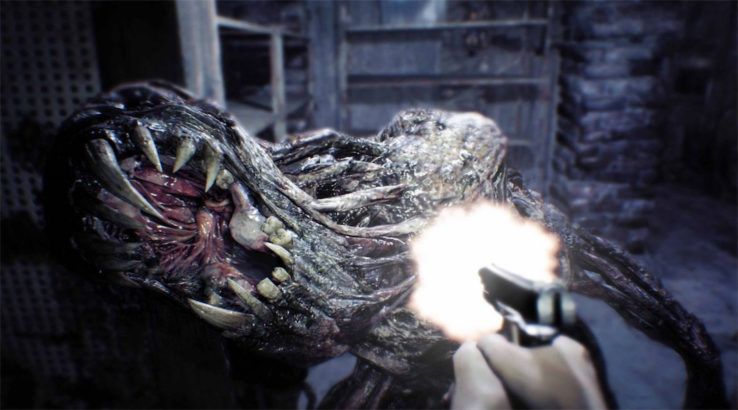Multiple rumors regarding the next Resident Evil game strongly suggest that werewolves will be in Resident Evil 8, or at least enemies strongly resembling such. But given some lore based on a Resident Evil comic book, as well as the way in which the virology of certain viruses are constructed in the Resident Evil universe, werewolves could easily be a welcome inclusion within Resident Evil's current canon.
Though it is questionable whether the Resident Evil: The Official Comic Magazine Issue #3, released in September 1998, is considered canon, it does not necessarily conflict with the lore of the Resident Evil universe and its established viral monstrosities, which could establish the basis for a werewolf in Resident Evil 8 too. In this comic book, the timeline takes place shortly before the events of the first Resident Evil game and included a werewolf that was killing people on Raccoon City's college campus.
Original Resident Evil Comic Book Werewolf
Resident Evil's Jill Valentine was dispatched by S.T.A.R.S. to investigate the incidents and ultimately killed the werewolf when she eventually confronted it. Upon death, the werewolf mutated back into a regular human form, and the public just believed the murders were committed by a crazed man.
In the timeline of the Resident Evil universe, Umbrella was already up to nefarious experiments in its underground laboratory below the Spencer Mansion in the Arklay Mountains. By this time, reports of murders and monstrous beings in the surrounding forests were already making their way down the grapevine, causing the public a lot of anxiety. This eventually led S.T.A.R.S. members on an investigation into the mountains shortly later, in which the events of Resident Evil 0 and 1 transpired. While the origins of this werewolf were never explained in this mostly forgotten comic, there is always the possibility it could have been one of Umbrella's experiments which escaped the confines of its Arklay Mountains' laboratory and made its way to Raccoon City.
But even if this comic book is not canon, or the werewolf has its own origins separate for Umbrella, the rumors surrounding Resident Evil 8's werewolves could still easily be construed into the Resident Evil universe with little conflict or change. Capcom would not even need to dabble in supernatural horror elements which classical werewolves are usually derived from and can instead stick with the biological-based horror that Resident Evil builds its monsters, plots, and themes upon.
T-Virus Can Explain Werewolf's Creation
For those who have read up on the virology of Resident Evil's lore, it is likely not the case that the particular werewolf from the comic book was an accidental byproduct of the T-Virus' exposure into the forests of the Arklay Mountains and more than likely would have been a type of Bio-Weapon intentionally created by Umbrella. This is because the combination of wolf and human genomes that comprise a werewolf would be a difficult task for the T-Virus to create accidentally upon mere exposure into the wilds. I
n the virology lore of the Resident Evil universe, the T-Virus has proven itself to be a great bonding agent for combining DNA from different species in order to create hybrid monstrosities, further mutated by the effects of the T-Virus itself. However, utilizing the T-Virus' bonding inter-species bonding properties requires some level of expertise in which this particular portion of the creation must be done intentionally, unlike other creatures which merely require mere exposure to the T-Virus in some form or method.
For example, Resident Evil's various Hunters were created by Umbrella using the T-Virus' bonding properties. Umbrella combined various genomes of amphibian and human DNA together in different ways, sometimes even using embryos, to create reptilian-like humanoids with some level of intelligence and a vicious ability to kill.
This created a number of different bio-engineered Hunter creatures, most notably the Hunter Beta and the Hunter Gamma, which were one of Umbrella's most diabolical experiments in Resident Evil. The Hunter was engineered to kill off any remaining survivors in a plague zone if the T-Virus alone could not finish the job.
Another example, which is perhaps more subtle, are the mutants infected with the C-Virus in Resident Evil 6, which portrayed many insect-like properties in their mutations. The C-Virus, or Chrysalid Virus, was created by combining the T-Veronica virus and G-Virus. Tracing the lore further back, the T-Veronica virus was originally created by combining Queen Ant DNA with the T-Virus and fusing the two in some capacity. This may explain the insect-like properties of the foot soldiers in Resident Evil 6 when they are exposed to the C-Virus through injections into the blood stream.
Establishing werewolves in the Resident Evil, possibly through some mechanism that combines wolf and human DNA, would be a fairly easy task to explain, whether Capcom decided to create an entirely new lineage of virology and its own origins or stick with established viruses, parasites, and infections to explain the matter. After all, if the former proves true, the Resident Evil series has not merely derived its lineage of monstrosities exclusively from the T-Virus or its original Progenitor virus strain.
Capcom Can Also Create a Totally New Werewolf Infection
Take for instance Resident Evil 4, which gave way to monstrous hosts infected by the Las Plagas parasites, which have no known connection to Umbrella or the Resident Evil universe's lore of biological lineage previously. The fictional Las Plagas parasites existed in a particular cave in a mountainous region of Spain and presented a completely new infection to the series with its own historical roots separate from the Progenitor Virus and T-Virus. These parasites were sought after not by Umbrella, but by its practical successor: Resident Evil's Tricell corporation.
The Mold in Resident Evil 7 also likely has its own historical roots, although there is a possible connection to Umbrella's past research, given a light mention of Albert Wesker's paramilitary group in aiding with the research of the Mold.
In a way, even the Nemesis in Resident Evil 3 has an element of its its own unexplained historical virology, comprising the parasite it is infected with, which was bio-engineered by Umbrella's laboratories in Europe. The origins of Resident Evil's Nemesis parasite were never fully explained but seemed completely separate from the T-Virus origins. Hopefully, the upcoming Resident Evil 3Remake will provide further explanation into the origins of this parasitic weapon which turns a regular Tyrant into the Nemesis.
In the Resident EvilArchives, concept-art for Resident Evil's Wildcat creature displays what appears to be a hybrid creature that is perhaps a combination of human and which appears to be a hybrid of a human and wildcat species. The creature never made the final cut in any Resident Evil game, but its concept art certainly demonstrates Capcom's consideration for further hybrid animal-human monstrosities.
There are many more examples of monsters in the Resident Evil universe which utilize new infectious creations with their own origins and roots, as well as examples of utilizing such experiments in creating Bio-Weapons that combine the properties of different species, including animals and humans. Whether Resident Evil 8 sticks with established lore or creates some sort of new and infectious monstrosity with its own historical roots, werewolves, or werewolf-like creatures, are a fairly easy monstrosity to bring into the foray of the Resident Evil universe anytime.
Resident Evil 8 is rumored to be in development.







